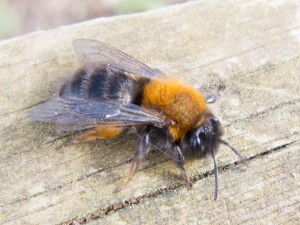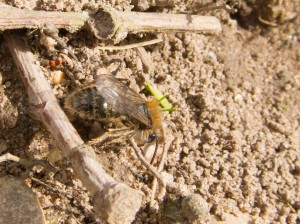I went to Brandon Marsh recently to see if I could see anything different bird-wise and so, armed with telescope, sound recording gear and small digital camera off I went. Birding was pretty much a wipe out unfortunately (see additional post), but as I didn’t have my macro lens with me I was bound to see something I wanted to photograph.
I noticed my first small bees of the season (buff-tailed bumble bee and honey bee notwithstanding) – there were quite a few buzzing about and they seemed to be nesting in small holes in the ground – therefore they must be mining bees. In fact, one nest site was on a path to a hide and I was worried I might stand on some. I have seen a couple of mining bees before (ashy and tawny) and despite the fact that these were red in colour they were neither of the above.
 It looked at first as though there might be two different types as there were some that were much paler in colour, but they did seem to be sharing the same nesting sites and holes, and I therefore concluded that they must be males to the red coloured females. Sexual dimorphism (where there are visible differences between the males and females) seems to occur quite often in bees.
It looked at first as though there might be two different types as there were some that were much paler in colour, but they did seem to be sharing the same nesting sites and holes, and I therefore concluded that they must be males to the red coloured females. Sexual dimorphism (where there are visible differences between the males and females) seems to occur quite often in bees.

Unfortunately I got the ID wrong on these, but was corrected by a lovely iSpot member. These are the male and female Clarke’s Mining Bee (Adrena Clarkella). According to the BWARS site they are often the first solitary bee out in the spring – sometimes as early as February and continue flying until May. They like pollen from Willow – hence the large number around Brandon Marsh I assume. They built their nests on a sandy slope – presumably to catch the sun. The bees seem fairly tame – so I think that next time my macro lens will come with me to try and get some better shots. Now that I’ve seen it once I hope I’ll be able to recognise it the next time.